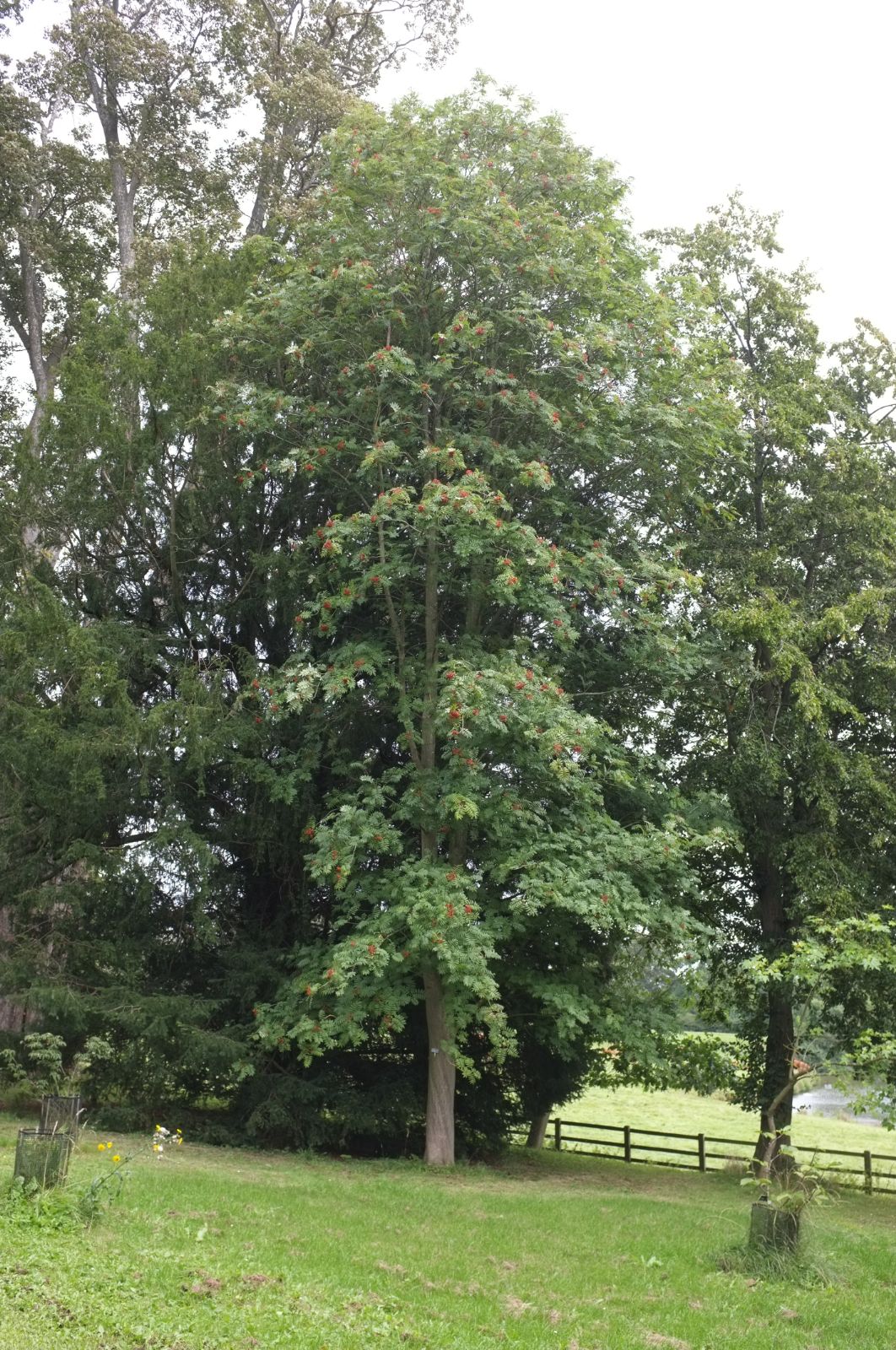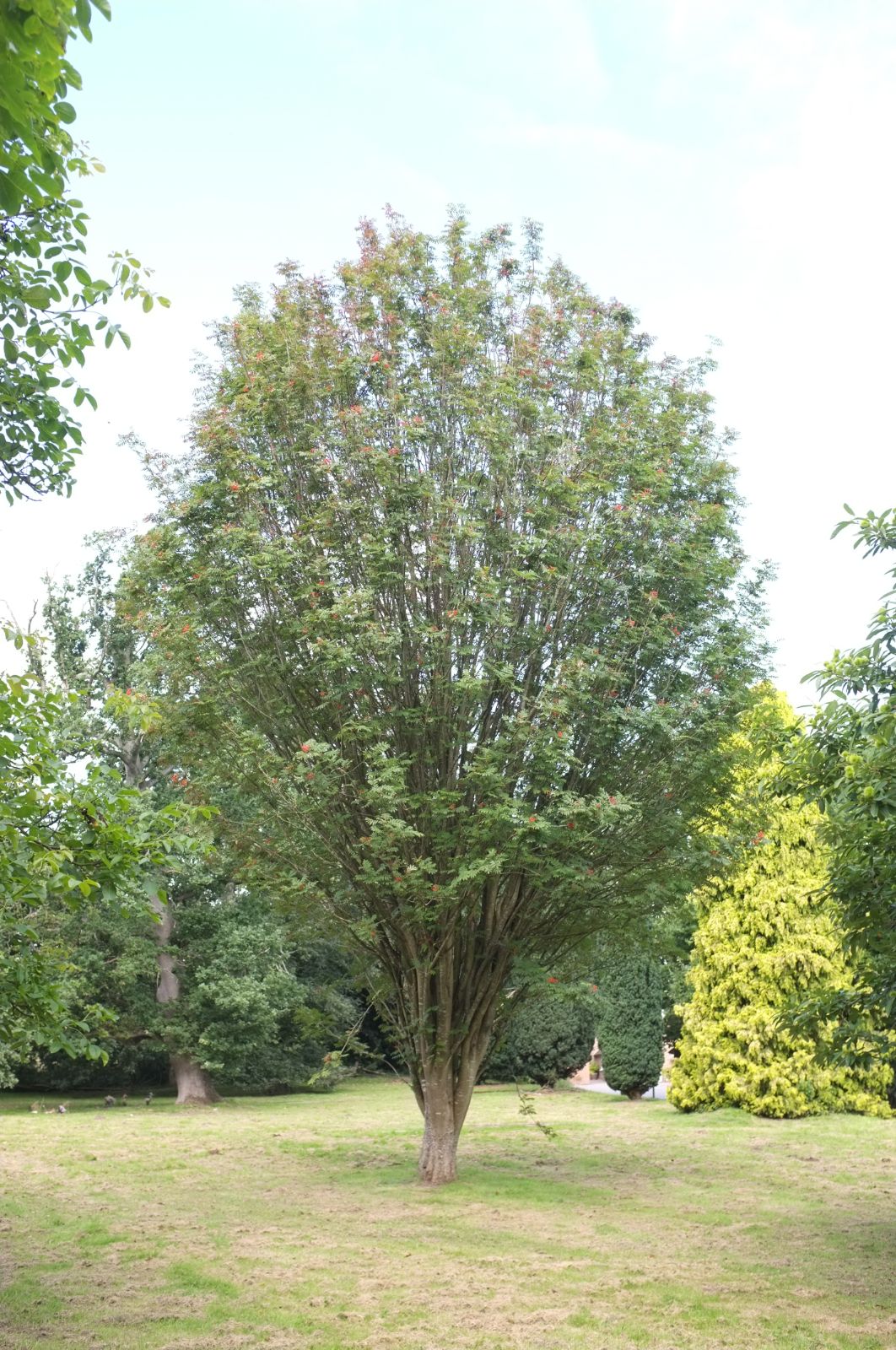Sorbus commixta
Sponsor
Kindly sponsored by
This genus has been sponsored and new text is being prepared.
Credits
Article from Bean's Trees and Shrubs Hardy in the British Isles
Recommended citation
'Sorbus commixta' from the website Trees and Shrubs Online (treesandshrubsonline.
Genus
Synonyms
- S. aucuparia var. japonica Maxim.
- S. japonica (Maxim.) Koehne, not Hedl.
- S. serotina Koehne (see cv. 'Serotina')
- S. pruinosa Koehne
- S. reflexipetala Koehne
- S. or Pyrus discolor Hort., not S. discolor (Maxim.) Maxim.
Infraspecifics
Other taxa in genus
- Sorbus americana
- Sorbus amoena
- Sorbus arachnoidea
- Sorbus aucuparia
- Sorbus carmesina
- Sorbus cashmiriana
- Sorbus coxii
- Sorbus decora
- Sorbus discolor
- Sorbus ellipsoidalis
- Sorbus esserteauiana
- Sorbus fansipanensis
- Sorbus foliolosa
- Sorbus forrestii
- Sorbus glabriuscula
- Sorbus glomerulata
- Sorbus gracilis
- Sorbus helenae
- Sorbus hupehensis
- Sorbus hypoglauca
- Sorbus insignis
- Sorbus 'Joseph Rock'
- Sorbus khumbuensis
- Sorbus koehneana
- Sorbus kongboensis
- Sorbus kurzii
- Sorbus lingshiensis
- Sorbus matsumurana
- Sorbus microphylla
- Sorbus muliensis
- Sorbus olivacea
- Sorbus parvifructa
- Sorbus pohuashanensis
- Sorbus poteriifolia
- Sorbus prattii
- Sorbus pseudohupehensis
- Sorbus pseudovilmorinii
- Sorbus randaiensis
- Sorbus reducta
- Sorbus rinzenii
- Sorbus rubescens
- Sorbus rufopilosa
- Sorbus rushforthii
- Sorbus sambucifolia
- Sorbus sargentiana
- Sorbus scalaris
- Sorbus sitchensis
- Sorbus tianschanica
- Sorbus ursina
- Sorbus vilmorinii
- Sorbus wallichii
- Sorbus wilsoniana
A tree to about 35 ft high in Japan, with ascending branches; twigs glabrous, reddish brown, roughened with numerous prominent lenticels; winter-buds about 3⁄4 in. long, acute, glabrous, green or reddish brown, usually not glutinous on trees cultivated in this country. Leaves up to 10 in. long, including petiole up to 13⁄4 in. long, with mostly six to eight pairs of leaflets; rachis grooved, not winged, glabrous, it and the petiole usually stained with red. Lateral leaflets narrowly to broadly lanceolate or oblong-lanceolate, 11⁄2 to 23⁄4 in. long, 3⁄8 to 1 in. wide, acuminately narrowed at the apex to a slender tip, sharply serrated almost to the base, the teeth finely pointed, frequently double, upper surface dark or medium green, finely reticulated and sublustrous, paler beneath, glabrous on both sides, or with light brown hairs along the midrib beneath. Flowers opening in late spring. Inflorescence 4 to 6 in. across, flat, glabrous or sparsely furnished with pale brown hairs, densely lenticellate. Flowers 1⁄4 to 3⁄8 in. wide, white; receptacle glabrous; petals roundish, about 3⁄16 in. long. Stamens almost as long as the petals, with purplish anthers. Styles three or four. Fruits globose, bright red, lustrous, ripening in autumn, about 3⁄8 in. wide, with a dry flesh. Bot. Mag., n.s., t. 166, as S. serotina.
A native of Japan, Sakhalin and Korea (for the closely related S. randaiensis of Formosa, see below). The species is a somewhat variable one in the length and relative breadth of the leaflets, in the degree of taper at the apex, and in their toothing, as well as in the presence or absence of hairs on the undersides of the leaflets and in the inflorescence (see further under var. rufo-ferruginea). But the variations are certainly not enough to justify the extraordinarily large number of species that Koehne, a notorious splitter, made out of them. There have been three recorded introductions of S. commixta, and their nomenclature is very confused:
1. S. commixta first reached this country from Späth’s nursery towards the end of the last century and was grown as Sorbus or Pyrus aucuparia var. japonica. But it seems to have attracted little attention.
2. Towards the end of the 19th century, seed reached Europe, apparently from the Arnold Arboretum, under the erroneous name of Pyrus or Sorbus discolor, and in Britain this introduction continued to bear this name in gardens until the middle of the present century or even later. On the continent the nomenclature became more involved. Seedlings in Späth’s nursery were identified by Koehne as S. matsumarana, a quite different species. Later he identified them as S. commixta but described one of Späth’s trees as a new species, S. serotina (see cv. ‘Serotina’).
3. In the early 1930s Messrs Marchant received seed from the Chugai Nursery Company of Japan as S. matsumarana, and plants were distributed under this name. The leaflets in this form of S. commixta are brown-hairy along the midrib and rather broad and shortly pointed. A tree at Borde Hill in Sussex received as S. matsumarana from Messrs Marchant was identified by A. B. Jackson as S. commixta var. rufo-ferruginea (see below), and it is really intermediate between that variety and the typical state. Jackson’s identification of the false S. matsumarana was not publicised, and it was under its erroneous name that this form of S. commixta received an Award of Merit on 28 October 1958 for its autumn colour and fruits. This form of S. commixta retains a narrow habit even in age, and grows rather taller than the maximum height given for wild trees; the tree at Borde Hill mentioned above, planted about 1930, measures 50 × 31⁄2 ft (1971).
From the Supplement (Vol. V)
specimens: Sheffield Park, Sussex, 56 × 51⁄4 ft at 3 ft (1974); Hergest Croft, Heref., 49 × 21⁄4 ft (1985); Thorp Perrow, Bedale, Yorks., 42 × 41⁄4 ft (1981); Alnwick Castle, Northumb., 42 × 41⁄2 ft at 1 ft (1977); Edinburgh Botanic Garden, 50 × 41⁄4 ft (1985); Tyninghame, E. Lothian, 56 × 21⁄2 ft (1984); Dawyck, Peebl., 23 × 3 ft (1984); Tannadyce, Angus, 56 × 21⁄4 ft (1981); Crichie House, Aberd., 46 × 31⁄4 ft (1980).
'Embley'
A selection from the former “S. discolor” of gardens, distributed by Messrs Hillier. It has steeply ascending branches, and colours rather later than trees grown as typical S. commixta.Dr Wilfrid Fox had a tree of S. commixta at Winkworth received under the name S. discolor (see introduction 2 above). He was aware that this tree had nothing to do with the true S. discolor, and considered it to be an intermediate species or hybrid between S. commixta and S. rufo-ferruginea or S. serotina, both of which are here included in S. commixta. He had intended to describe it in his treatise on Sorbus under the name S. embleyensis, in honour of J. J. Crossfield of Embley Park, Romsey, in whose garden he first saw an example of the “S. discolor” of gardens. The original tree in the Winkworth Arboretum no longer exists, but a specimen from it is preserved at Kew. It was evidently not quite the same as the tree named ‘Embley’ by Messrs Hillier, which received an Award of Merit in 1971 for its autumn colour.'Serotina'
This cultivar of S. commixta was described by Koehne, as S. serotina, from a plant raised in Späth’s nursery, Berlin, from seeds received under the name Pyrus discolor (see introduction 2 above). A plant was acquired from Späth about 1930 for the Royal Horticultural Society’s Garden at Wisley, and scions from this were given to Messrs Marchant in 1935. ‘Serotina’, as the name implies, is a late grower – Koehne noted that it leafed and flowered two weeks later than the plants that he considered to represent the true S. commixta (these too grew in Späth’s collection). The tree in the Winkworth Arboretum also ripens its fruits and colours later in the autumn than most forms of S. commixta. The leaves of ‘Serotina’ have mostly six pairs of rather short, elegantly toothed leaflets; there are some brown hairs in the inflorescence and on the undersides of the leaflets, but these have mostly disappeared by late summer. Its fruits are brownish red.The S. serotina of Bot. Mag., n.s., t. 166 is not ‘Serotina’, but some other form of S. commixta. The material portrayed came from a tree at Dawyck, which had been bought from Messrs Veitch.S. randaiensis (Hayata) Koidz. S. aucuparia var. randaiensis Hayata – This very close ally of S. commixta grows in the mountains of Formosa at altitudes of 10,000 to 12,500 ft. The differences between the two species are elusive, but the leaflets of S. randaiensis are narrower, being rarely more than {1/2} in. wide, and may be in as many as ten pairs. The trees under this name were originally distributed by Messrs Marchant, who received their stock from the Chugai Nursery Company of Kobe, Japan, in the late 1930s, and there is some doubt as to their authenticity. But whatever the identity of these trees, they are in effect a fine selection of S. commixta, very vigorous and of exceptionally narrow habit. They colour just as well in autumn and, unlike some forms of S. commixta, they are very free-fruiting, bearing the clusters on long spurs well clear of the foliage.var. rufoferruginea Shirai ex Schneid.
Synonyms
S. rufo-ferruginea (Schneid.) Schneid
Although S. commixta is often described as completely glabrous, light brown hairs often occur on the undersides of the leaflets, on the rachis, and in the inflorescence, but are not a conspicuous feature. In the var. rufo-ferruginea, however, the hairs are darker and denser; in one specimen in the Kew Herbarium, collected in the wild in late July, the whole undersurface of the leaflets is coated with brown wool. There is a fine group of the true variety in the Winkworth Arboretum. The plants are of spreading habit and colour beautifully in autumn; the fruits last until the end of November in some seasons. These plants match the type of var. rufo-ferruginea in having narrow leaflets {5/8} to {3/4} in. wide.







